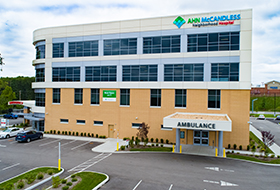Coordinated care, closer to home: Investments pay off for patients
Three days after James "Tim" Walter was diagnosed with COVID-19, he was laboring to breathe. And by that evening — November 13, 2020 — it was clear that Tim would need to be hospitalized. His wife, Kathleen Walter, drove him to the newly opened AHN McCandless Neighborhood Hospital, about 5 miles from their Glenshaw home.
"I had to ride with my face out the window," Tim said. "I couldn't catch my breath."
Kathleen, who is a nurse practitioner for another health care organization, was stunned by how quickly her husband was evaluated by the AHN McCandless emergency department staff.
"I dropped him off and went to park my car," she said. "By the time I parked, just a few minutes later, he had already been taken back."
The decision to take Tim to AHN McCandless rather than a larger city hospital was "the best thing that could have happened to him," Kathleen said. Within an hour, he'd already had blood work, X-rays, a CT scan, and he'd been started on oxygen and intravenous medications.
"If we would have taken him into the city on a Friday night, there's no way he would have been seen and treated that quickly," Kathleen said.
After Tim was stabilized, the clinicians at AHN McCandless made the decision to transfer him to West Penn Hospital's COVID-19 unit, where he was admitted later that night. Because the details of Tim's condition had already been communicated to West Penn, his course of care — which included convalescent plasma, antiviral remdesivir, corticosteroids, and high-flow oxygen — was established in advance, and was administered immediately upon his arrival.
Because Kathleen was self-quarantining due to her own possible COVID-19 exposure, she didn't see Tim for several days following his transfer to West Penn. But she was kept up to date on his condition thanks to daily communication with the COVID-19 unit's attending physician.
And six days later, Tim was discharged, home in plenty of time for Thanksgiving dinner.
Everything about his care — from an initial November 10 telephone consultation, to the brief stay at AHN McCandless, to his six days at West Penn — went according to plan, Kathleen said.
That plan has been several years in the making. When AHN decided to build four neighborhood hospitals in western Pennsylvania, it couldn't have anticipated COVID-19 or the unprecedented challenges that 2020 would bring.
But it did anticipate a scenario just like the one the Walters experienced — a patient who needs emergency care, closer to home.
AHN's ongoing clinical and capital investments — including its 2020 investment in enhanced telehealth, telephone triage, and video visit capabilities, necessitated by the COVID-19 pandemic — paid off in a big way last year for the Walters and many other patients.
"Working in health care myself, I'm not easily impressed. But from beginning to end, everyone worked together like a well-oiled machine, and everything happened at warp speed," Kathleen said. "This is exactly how health care is supposed to look."

Investments to expand care into the communities, including the AHN McCandless Neighborhood Hospital, have paid off for patients during COVID-19.












 Share This
Share This